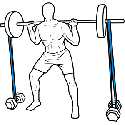Even with a book of 200 exercises sitting right in front of you, it can be hard to actually come up with your total body routine. How do you make sure you hit everywhere you should be? How many exercises should you have? How many sets and repetitions should you do?
Today, we are going to go through the basic layout of your routine and we will get into the specifics in later posts.
Warm Up
You need a good 5-10 minutes of easy exercise. This could be some jumping jacks, a light jog, or running through a few of your exercises without resistance bands.
Stretch
You want to give yourself 5-10 minutes of quality stretches.
Exercise
For your total body routine, start with your biggest muscle groups and work your way down the smaller ones. This is called vertical loading. This design is important because it keeps you from tiring out too early in your workout. Basically, you use your smaller muscles in exercises that also work your larger muscles. You do not want to tire out the small muscles before you even get a chance to tackle your larger ones. For example, in exercises that work larger muscles like legs, you also use your core muscles. If you start with an exercise that targets your core muscles, you will exhaust them and not be able to fully train the leg muscles.
The sequence should generally look like this: legs, chest, back, shoulders, triceps, biceps, and core.
Cool Down
Similar to the warm-up, this is where you slow down your movement and get your body ready to stop exercising.
Stretch
Give yourself a solid 10-15 minutes of stretching after you finish your workout. This is how you can really help yourself avoid injury. Try to incorporate your resistance bands into your stretches – they can help you reach those hard-to-get-to muscles.
Come back next week when we will discuss how many sets and repetitions you need in your workout. Review your workout goals because these numbers will differ depending on what you want out of your exercise.



